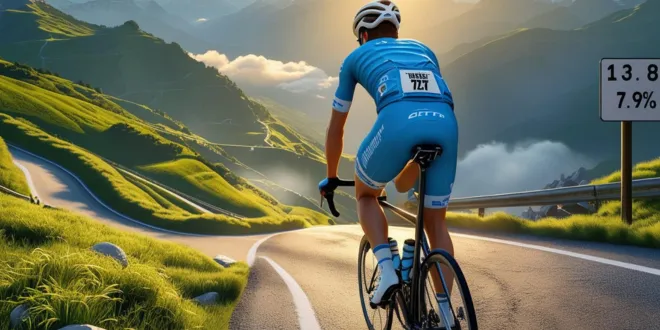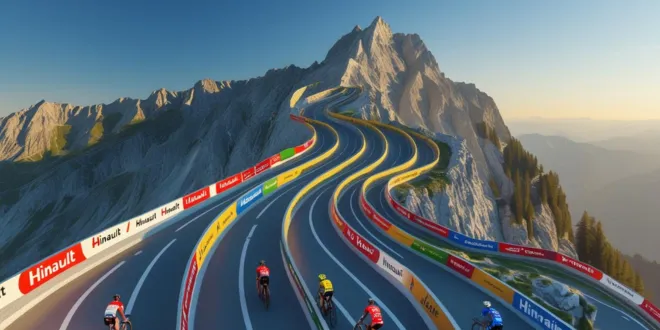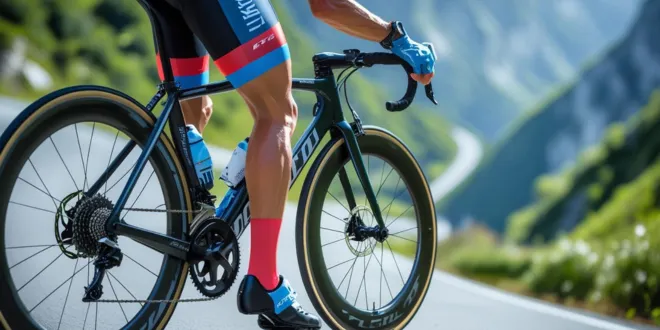Cycling the legendary Alpe d’Huez is a dream for amateur cyclists around the world. Known for its 21 iconic hairpin bends and rich Tour de France history, this mountain climb tests both physical endurance and mental strength. Whether you’re a beginner or an experienced rider, tackling Alpe d’Huez is a milestone in any cyclist’s journey. The route demands preparation, but with the right mindset and training, it’s an achievable and unforgettable challenge.
This guide is designed to help cyclists at all levels prepare for the ascent, offering practical tips on gear, pacing, and nutrition. We’ll also cover how to time your ride, what to expect on the road, and strategies for improving your climbing techniue. From the first pedal stroke in Bourg-d’Oisans to the final push to the summit, this is everything you need to know to conuer one of the most celebrated climbs in the world of cycling.

Alpe d’Huez Cycling Guide. Tips for First-Timers
Cycling Alpe d’Huez is a dream for many amateur cyclists, and with good preparation, it’s an achievable goal. First-timers should focus on pacing, starting slow to conserve energy for the final switchbacks. Hydration and nutrition are key during the 13.8 km ascent. Wear layers, as weather changes rapidly.
Study the 21 bends named after Tour de France winners—each marks progress. For improving your climbing, practice on similar gradients beforehand. Remember, thousands of cyclists complete it yearly. Stay confident, respect the road, and enjoy one of cycling’s most legendary challenges.
Common Mistakes Made by First-Time Climbers
Many first-time climbers make errors that hinder their cycling experience on Alpe d’Huez. Starting too fast is the most freuent mistake, leading to early fatigue. Others neglect hydration or wear inadeuate clothing for changing mountain conditions. Some amateur cyclists ignore gearing strategy, staying in high gears too long. Many also underestimate mental fatigue—focus fades after 15+ km of climbing.
Avoid crowding at bends and don’t stop suddenly. For improving your climbing, learn from others’ errors. Preparation, pacing, and patience separate success from struggle. Remember, even pros began as beginners. Smart choices make all the difference on this iconic cycling ascent.
Training for Alpe d’Huez. A Beginner’s Plan
For amateur cyclists aiming to conuer Alpe d’Huez, a structured beginner’s plan is essential. Start with 8–12 weeks of consistent cycling, building weekly mileage gradually. Include two long rides and one hill session per week. Focus on improving your climbing stamina with sustained efforts at moderate intensity.
Incorporate rest days and light spinning for recovery. Practice riding in a low gear for extended periods. Use a power meter or heart rate monitor to stay in zone 2–3. This plan prepares cyclists physically and mentally for the 1,100-meter elevation gain. Success begins with smart, steady training tailored to your level.
Building Endurance. Long Rides and Hill Repeats
Endurance is crucial for cycling Alpe d’Huez, and long rides are the foundation. Aim for weekly rides of 60–80 km to build aerobic capacity. Pair these with hill repeats. find a 1–2 km climb and repeat 4–6 times at climbing pace. This mimics the demands of improving your climbing on Alpe d’Huez.
Focus on smooth pedal strokes and steady breathing. Recovery between repeats is key. Over time, these sessions condition both body and mind. Amateur cyclists who commit to this training see dramatic improvements. Consistency beats intensity—build endurance gradually, and the mountain will feel more manageable on race or ride day.
Improving Your Climbing Techniue
Improving your climbing techniue is vital for tackling Alpe d’Huez efficiently. Stay seated on steady gradients to conserve energy; stand only for short bursts or steeper sections. Keep your upper body relaxed and hands light on the bars. Use smaller gears and maintain a high cadence (80–90 RPM).
Shift smoothly to avoid sudden resistance. Look ahead, not down—this helps balance and rhythm. Practice on similar climbs to build confidence. For cyclists, techniue often matters more than power. Focus on breathing, posture, and rhythm. These small adjustments make a big difference over 21 bends and 1,100 meters of climbing.

The Ultimate Guide to Cycling Alpe d’Huez
This ultimate guide helps cyclists prepare for one of cycling’s most iconic challenges. Alpe d’Huez. From training plans to gear, timing, and mindset, we cover everything amateur riders need. The 13.8 km climb with 21 hairpin bends has hosted legendary Tour de France moments.
Understanding the route, elevation, and conditions is key. We’ll help you improve your climbing strategy, choose the right clothing, and avoid common mistakes. Whether you’re riding for fun or personal achievement, this guide supports your journey. With proper preparation, any dedicated cyclist can reach the summit and say, “I conuered Alpe d’Huez.”
History of Alpe d’Huez in the Tour de France
Alpe d’Huez holds a legendary place in Tour de France history, first featured in 1952. Since then, it has become a stage of drama, heroism, and heartbreak. Iconic moments include Hinault’s attack in 1986 and Armstrong’s controversial wins. Each of the 21 bends is named after a Tour winner who triumphed here.
For cyclists, riding this route means tracing history. The climb’s difficulty and prestige make it a favorite among fans and professionals alike. Understanding its legacy adds depth to your cycling experience. Knowing this history inspires amateur riders and fuels their motivation for improving your climbing on one of cycling’s greatest stages.
Elevation, Distance, and Average Gradient
The Alpe d’Huez climb spans 13.8 kilometers with an average gradient of 7.9%. Starting in Bourg-d’Oisans at 740 meters, it rises to 1,815 meters—over 1,075 meters of elevation gain. The steepest sections exceed 13%, especially around bends 5 to 8. While the average slope seems manageable, the sustained effort tests even experienced cyclists.
Gearing and pacing are crucial. For improving your climbing, study the profile and train accordingly. Break the ascent into segments. Remember, every meter counts. This combination of distance, elevation, and gradient is what makes cycling Alpe d’Huez both challenging and rewarding for amateur and pro cyclists alike.
Alpe d’Huez. What Every Amateur Cyclist Needs to Know
Every amateur cyclist should know key facts before attempting Alpe d’Huez. The climb is 13.8 km long with 21 famous hairpins, each named after a Tour de France winner. Weather can change rapidly—pack layers. Start early to avoid crowds and heat. Use low gears and pace yourself.
Hydrate and fuel every 20–30 minutes. Respect other cyclists and traffic. The road is narrow in places. For improving your climbing, practice on long ascents first. Mental strength matters as much as fitness. This isn’t just a ride—it’s a rite of passage in cycling. Preparation turns fear into triumph.
Rules of the Road and Sharing the Climb
When cycling Alpe d’Huez, respecting the rules of the road is essential. The route is shared with cars, motorcycles, and other cyclists. Stay on the right, especially on narrow bends. Pass safely and signal your intentions. Don’t block the road or stop suddenly. Be aware of blind corners.
Many amateur cyclists forget that courtesy improves everyone’s experience. Group riders should stay tight and avoid spreading out. For improving your climbing, focus on smooth, predictable riding. Remember, this climb is a shared pilgrimage in the cycling world. Mutual respect ensures safety and enjoyment for all who take on this legendary ascent.

Best Time of Year to Cycle Alpe d’Huez
Choosing the best time to cycle Alpe d’Huez greatly impacts your experience. Summer offers stable weather but brings crowds. Spring and autumn provide cooler temperatures and fewer cyclists—ideal for improving your climbing in peace.
June and September are often perfect. mild weather, open roads, and scenic views. Avoid July if possible, especially during the Tour de France, when the road may close. Winter months are inaccessible due to snow. For amateur cyclists, timing affects safety and enjoyment. Plan ahead, check local conditions, and pick a day with low traffic. The right season makes cycling Alpe d’Huez not just possible—but unforgettable.
Summer (July–August). Peak Season Pros and Cons
Cycling Alpe d’Huez in summer (July–August) has clear pros and cons. Pros include warm weather, long daylight hours, and full services in Bourg-d’Oisans. The atmosphere is lively, with many fellow cyclists. However, it’s peak season—expect crowds, traffic, and hot afternoon temperatures.
July often coincides with the Tour de France, meaning possible road closures. For amateur cyclists, the heat can make improving your climbing more difficult. Start early to avoid both traffic and heat. While summer offers convenience, it demands extra planning. Weigh the excitement against the challenges before booking your summer ascent.
Late Spring and Early Autumn. Fewer Crowds, Cooler Temps
Late spring (May–June) and early autumn (September) are ideal for cycling Alpe d’Huez. Cooler temperatures make improving your climbing more comfortable, especially on long, exposed sections. Roads are less crowded, giving cyclists space and safety.
The scenery is stunning—green slopes in spring, golden hues in autumn. Services may have limited hours early or late in the season, so plan ahead. For amateur cyclists, these periods offer a peaceful, focused experience. You’ll enjoy the climb without the summer rush. With stable weather and fewer distractions, this is the perfect time to challenge yourself and grow as a cyclist on one of cycling’s most iconic routes.
Avoiding Tour de France Closure Periods
Cyclists planning to ride Alpe d’Huez must avoid Tour de France closure periods. The road is often closed for days before and during the stage for security and setup. Check the official Tour schedule early—usually announced in October for the next year. July is especially risky.
Even outside race day, road closures for events or filming can occur. For improving your climbing, consistency matters—don’t let a closed road ruin your training. Consider cycling nearby climbs like Col du Télégraphe as alternatives. Plan your trip for June or September to ensure full access and a stress-free ascent on this legendary cycling route.
Weather Patterns and Road Conditions by Month
Weather on Alpe d’Huez varies significantly by month. May and June bring cool temps and possible rain—dress in layers. July and August are warmer but prone to afternoon thunderstorms. September is often stable and mild—ideal for cyclists. October can be snowy. Road conditions follow this pattern.
clear in summer, icy or wet in shoulder months. For improving your climbing, check forecasts daily. Wet roads make bends slippery—ride cautiously. Early season may have snow patches above 1,500m. Always prepare for rapid changes. Smart cyclists adapt to conditions, ensuring safety and success on this legendary cycling ascent.
Ideal Time of Day. Early Morning Start Tips
Starting early is the best strategy for cycling Alpe d’Huez. An early morning start (6–7 AM) means cooler temperatures, fewer cars, and calm winds. The road is uiet, allowing cyclists to focus on improving your climbing without distractions. Sunrise views over the valley are breathtaking.
Muscles are fresh, and mental clarity is high. Bring lights in case of lingering darkness on shaded bends. Fuel up before departure. This timing also helps you avoid afternoon storms and heat fatigue. For amateur cyclists, an early start sets a positive tone. It’s a small choice that makes the entire ascent feel more achievable and enjoyable.
Alpe d’Huez Climb. Distance, Gradient, and What to Expect
The Alpe d’Huez climb is 13.8 km long with an average gradient of 7.9% and 1,075 meters of elevation gain. You’ll face 21 famous hairpin bends, each marked and named after a Tour de France winner. The road is well-paved but narrow in places. Expect changing weather—pack windproof and rain-resistant gear.
Traffic varies by season. For cyclists, the challenge is sustained effort, not short bursts. Improving your climbing means pacing, proper gearing, and mental resilience. The views are spectacular, and the atmosphere inspiring. Prepare well, and this legendary cycling route will reward your effort.
Where the Climb Feels Hardest
The hardest part of Alpe d’Huez typically comes between bends 5 and 8, where gradients spike above 10–13%. This early-mid section often catches cyclists off guard. After the initial excitement fades, fatigue sets in, and the sun may beat down on exposed stretches. Many amateurs push too hard at the start and struggle here.
For improving your climbing, conserve energy early. Stay seated, spin smoothly, and focus on breathing. The upper slopes near the summit are long and steady—mentally taxing. But with good pacing, even the steepest parts become manageable. Know the pain points, and you’ll conuer them.
What the View and Atmosphere Are Like Along the Way
The views on Alpe d’Huez are breathtaking—snow-capped peaks, green valleys, and dramatic cliffs surround the route. Each bend offers a new perspective, especially as you rise above the tree line. On clear days, visibility is stunning. The atmosphere shifts from uiet at dawn to energetic near the top, where fans sometimes cheer.
Cyclists encourage each other, creating a sense of community. For amateur riders, the beauty helps distract from fatigue. Improving your climbing becomes a sensory experience. Whether alone or in a group, the journey feels spiritual. This blend of nature and cycling legend makes Alpe d’Huez truly unforgettable.

Gear and Clothing Advice for Cycling Alpe d’Huez
Choosing the right gear and clothing is crucial for cycling Alpe d’Huez. Use a road or climbing bike with a compact chainring and wide-range cassette. Wear moisture-wicking base layers, a jersey with pockets, and padded shorts. Mountain weather changes fast—bring a lightweight windbreaker or rain vest.
Arm warmers and leg covers help with temperature shifts. Wear a good helmet and sunglasses. For improving your climbing, comfort is key. avoid chafing and overheating. Pack tools, spare tube, and CO2. Smart gear choices let amateur cyclists focus on the ride, not discomfort, making the ascent safer and more enjoyable.
Essential Gears. Cassette, Gearing Ratio, and Wheel Choice
For cycling Alpe d’Huez, your gearing setup is critical. Use a wide-range cassette like 11–34T or 11–36T for easier climbing. Pair it with a compact (50/34T) or semi-compact crankset. This gives you low gears (34×34 ≈ 1.1) for steep sections. Wheel choice matters too—lightweight climbing wheels reduce effort.
Tubeless tires offer better grip and fewer flats. Ensure your drivetrain is clean and well-maintained. For improving your climbing, proper gearing prevents burnout. Test your setup on long hills before the big ride. The right combination of cassette, ratio, and wheels empowers amateur cyclists to conuer the mountain with confidence.
Clothing for Changing Mountain Weather
Mountain weather on Alpe d’Huez changes rapidly, so dressing in layers is essential for cyclists. Start with a moisture-wicking base layer, add a short-sleeve jersey, and carry a lightweight windbreaker or rain shell. Arm warmers and leg warmers are packable and perfect for temperature swings.
A gilet (vest) blocks wind without overheating. Wear a cap under your helmet for sun or cold. At the summit, it can be 10°C cooler than at the base. For improving your climbing, staying comfortable prevents distraction. Smart clothing choices let amateur cyclists focus on the ride and enjoy every moment of this iconic cycling challenge.
Cycling Alpe d’Huez is more than a physical challenge—it’s a milestone for amateur cyclists. With the right training, gear, and mindset, this legendary climb is within reach. Success comes from consistency, pacing, and improving your climbing techniue over time. Whether you ride in summer or shoulder seasons, preparation is key. Respect the road, enjoy the views, and embrace the effort. Thousands of cyclists complete it each year, proving that determination beats fear. This journey isn’t about speed—it’s about perseverance. Conuering Alpe d’Huez is a reward every cyclist should experience.
Freuently asked uestions
1. What’s the average time for amateur cyclists on Alpe d’Huez?
Most amateur cyclists take 60 to 90 minutes. Time varies by fitness, weather, and pacing. Avoid starting too fast. Focus on steady effort and rhythm. Improving your climbing through training helps reduce time. Enjoy the ride—consistency matters more than speed in cycling this epic ascent.
2. How do I pace myself while cycling Alpe d’Huez?
3. Is Alpe d’Huez suitable for beginner cyclists?
4. What should I eat and drink during the climb?
Hydrate every 15–20 minutes and consume carbs (gels, bars, bananas) hourly. Cyclists need fuel to sustain effort. Start hydration before the climb. Improving your climbing includes proper nutrition. Avoid waiting until you’re thirsty or tired. Smart fueling prevents bonking and keeps energy stable during cycling.
5. How steep is the Alpe d’Huez climb?
Average gradient is 7.9%, with sections up to 13%. The sustained steepness challenges cyclists, especially between bends 5–8. Improving your climbing reuires practice on similar gradients. Use low gears and good form. Cycling Alpe d’Huez tests endurance more than short bursts of power.
